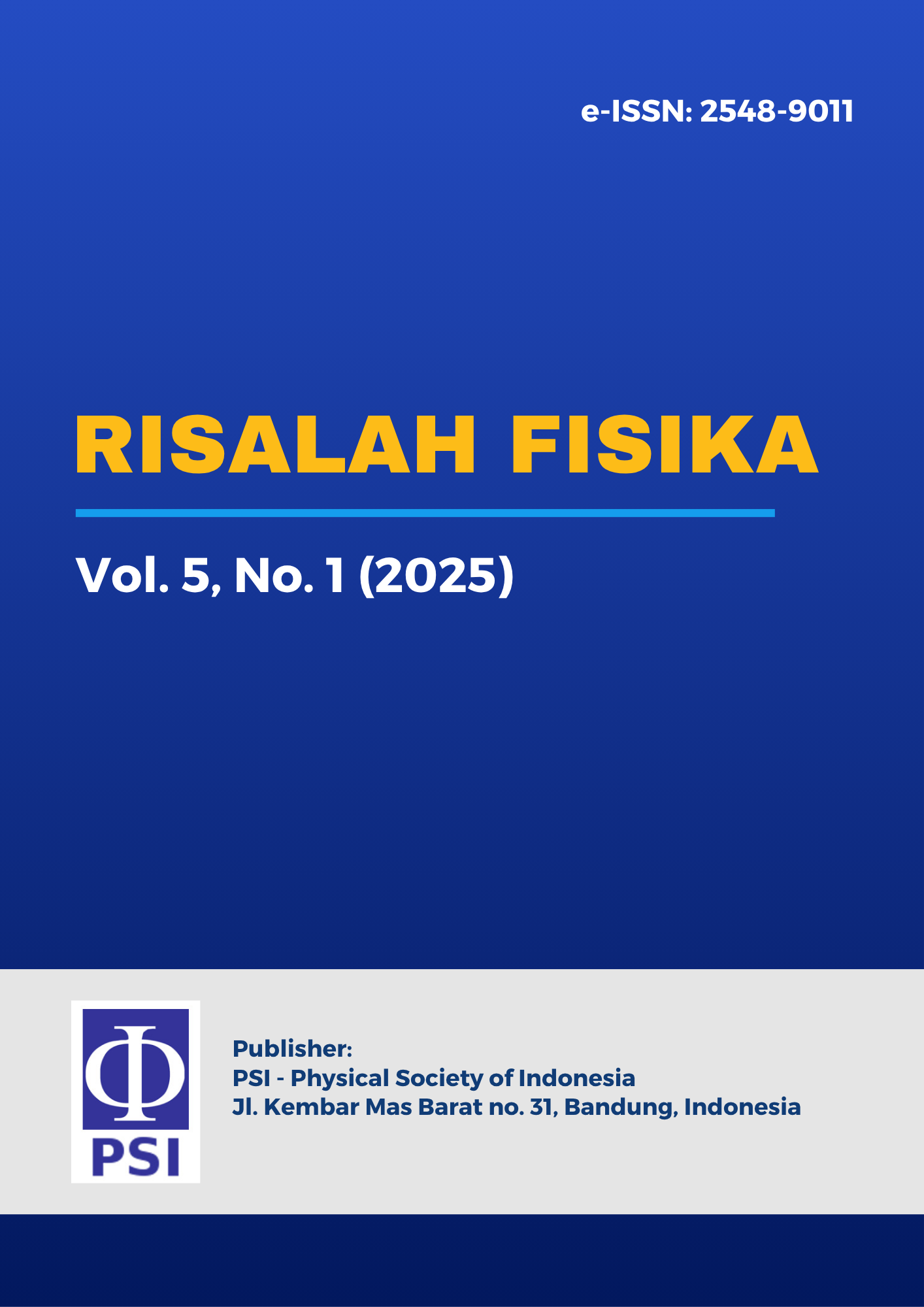Analysis of the Relationship Between Temperature and Extreme Rainfall with Drought and Flood Events in Lampung Province
DOI:
https://doi.org/10.35895/rf.v5i2.27Kata Kunci:
extreme, temperature, rainfall, climate, hydrometeorologyAbstrak
The extreme temperature and rainfall studied in this study have a clear purpose, namely to identify recurring patterns that occur in a certain time span related to the level of rainfall in a certain region. By analyzing the data, it is hoped that it will be possible to better understand the weather and climate dynamics in the context of the region, as well as to enable the development of more effective adaptation and mitigation strategies against the impacts of climate change. This study uses RClimDex to identify temperature and precipitation data to be observed in the year from 1981-2022. The results show extreme rainfall temperatures in the Lampung Province area if there are no optimal countermeasures, projections of climate conditions in the region in the next 100 years show a tendency to decrease rainfall and increase temperature. With increasingly rare rainfall and significantly rising air temperatures, this has the potential to trigger droughts and fires. But the government also needs to pay attention to the threat of hydrometeorological disasters that can arise due to heavy rainfall.
Referensi
Aditama. (2000). Impact of haze from forest fire to respiratory health: Indonesian experience. In Respirology (Vol. 5).
Aguilar, E., Barry, A. A., Brunet, M., Ekang, L., Fernandes, A., Massoukina, M., Mbah, J., Mhanda, A., do Nascimento, D. J., Peterson, T. C., Umba, O. T., Tomou, M., & Zhang, X. (2009). Changes in temperature and precipitation extremes in western central Africa, Guinea Conakry, and Zimbabwe, 1955- 2006. Journal of Geophysical Research Atmospheres, 114(2). https://doi.org/10.1029/2008JD011010
Akhsan, H., Irfan, M., Supari, & Iskandar, I. (2023). Dynamics of Extreme Rainfall and Its Impact on Forest and Land Fires in the Eastern Coast of Sumatra. In Science and Technology Indonesia (Vol. 8, Issue 3, pp. 403–413). Magister Program of Material Sciences, Graduate School of Sriwijaya University. https://doi.org/10.26554/sti.2023.8.3.403-413
Ariska, M., Akhsan, H., Muslim, M., Sudirman, & Kistiono. (2022). Pengaruh El Niño Southern Oscillation(ENSO) dan Indian Ocean Dipole(IOD) Terhadap Curah Hujan dan Korelasinya dengan Consecutive Dry Days(CDD) Provinsi Sumatera Selatandari Tahun 1981-2020. Jurnal Ilmu Fisika Dan Pembelajarannya (JIFP), 6(2), 31–41. http://jurnal.radenfatah.ac.id/index.php/jifp/
Ariska, M., Suhanda, A., Suhadi, S., Supari, S., Irfan, M., & Iskandar, I. (2024). Exploration of Seasonal Dynamics of Tropical Indo-Pacific Ocean during Dry, Wet and Neutral Years in Indonesia using Composite Method. Jurnal Penelitian Fisika dan Aplikasinya (JPFA), 14(1).
Ariska, M., Irfan, M., & Iskandar, I. (2024). Detection of Dominant Rainfall Patterns in Indonesian Regions Using Empirical Orthogonal Function (EOF) and Its Relation with ENSO and IOD Events. Science and Technology Indonesia, 9(4), 1009-1023.
Ariska, M., Suhadi, S., Supari, S., Irfan, M., & Iskandar, I. (2024, April). The effect of El Niño Southern oscillation (ENSO) on rainfall and correlation with consecutive dry days (CDD) in Palembang city. In AIP Conference Proceedings (Vol. 3052, No. 1). AIP Publishing.
Ariska, M., Darmawan, A., Akhsan, H., Supari, S., Irfan, M., & Iskandar, I. (2023). Pemodelan Numerik Hubungan Pola Curah Hujan Wilayah Equatorial di Pulau Sumatera Terhadap Fenomena ENSO dan IOD. Jurnal Teori Dan Aplikasi Fisika, 95-106.
Ariska, M., Putriyani, F. S., Akhsan, H., Supari, S., Irfan, M., & Iskandar, I. (2023). Trend of Rainfall Pattern in Palembang for 20 Years and Link to El-niño Southern Oscillation (ENSO). Jurnal Ilmiah Pendidikan Fisika Al-Biruni, 12(1), 67-75.
Ariska, M., Suhadi, S., & Herlambang, D. K. (2023). Empirical Orthogonal Function (EOF) Analysis Based on Google Colab on Sea Surface Temperature (SST) Dataset in Indonesian Waters. Indonesian Physical Review, 6(1), 20-32.
Ariska, M., Akhsan, H., & Muslim, M. (2022). Impact Profile of Enso and Dipole Mode on Rainfall as Anticipation of Hydrometeorological Disasters in the Province of South Sumatra. Spektra: Jurnal Fisika dan Aplikasinya, 7(3), 127-140.
Badsha, M. A. H., Abdulla, M., Kafi, H., Hashnat Badsha, M. A., Kafi, M. A. H., Islam, M. Z., & Islam, T. (2016). Analysis of the Trends in Temperature and Precipitation Variables for SylhetCity of Bangladesh using Rclimdex Toolkit. In KUET. https://www.researchgate.net/publication/290649725
Beherea, S. K., & Yamagata, T. (2001). Subtropical SST dipole events in the southern Indian Ocean. Geophysical Research Letters, 28(2), 327–330. https://doi.org/10.1029/2000GL011451
Chang, C.-P., Wang, Z., Mcbride, J., & Liu, C.-H. (2005). Annual Cycle of Southeast Asia-Maritime Continent Rainfall and the Asymmetric Monsoon Transition.
Chervenkov, H., & Slavov, K. (2019). STARDEX and ETCCDI climate indices based on E-OBS and CARPATCLIM: Part two: ClimData in use. Lecture Notes in Computer Science (Including Subseries Lecture Notes in Artificial Intelligence and Lecture Notes in Bioinformatics), 11189 LNCS, 368–374. https://doi.org/10.1007/978-3-030-10692-8_41
Collischonn, B., Collischonn, W., & Tucci, C. E. M. (2008). Daily hydrological modeling in the Amazon basin using TRMM rainfall estimates. Journal of Hydrology, 360(1–4), 207–216. https://doi.org/10.1016/j.jhydrol.2008.07.032
Fitriyah, N., Krisnando Nathanael, G., Daud, R. F., Winangsih, R., Kania Kurniawati, N., Mitrin, A., Akib, S., Putra Ode Amane, A., & Winarti, Y. (2023). Metode Penelitian Ilmu Komunikasi. www.penerbitwidina.com
Fuso Nerini, F., Sovacool, B., Hughes, N., Cozzi, L., Cosgrave, E., Howells, M., Tavoni, M., Tomei, J., Zerriffi, H., & Milligan, B. (2019). Connecting climate action with other Sustainable Development Goals. In Nature Sustainability (Vol. 2, Issue 8, pp. 674–680). Nature Publishing Group. https://doi.org/10.1038/s41893-019-0334-y
Hackert, E. C., & Hastenrath, S. (1986). Mechanisms of Java rainfall anomalies. Monthly Weather Review, 114(4), 745–757. https://doi.org/10.1175/1520- 0493(1986)114<0745:MOJRA>2.0.CO;2
Hadiansyah, R., Indranata, A. L., Silitonga, A. K., & Agus Winarso, P. (2018). Kajian Kondisi Atmosfer saat Kejadian Hujan Ekstrem di Padang Sumatera Barat (Studi Kasus Tanggal 14 Februari 2018). Prosiding SNFA (Seminar Nasional Fisika Dan Aplikasinya), 246–257. http://apps.ecmwf.int/datasets/data/interim-full-
Hadiansyah, R., Indranata, A. L., Silitonga, A. K., Agus Winarso, P., Studi Klimatologi, P., Tinggi Meteorologi Klimatologi dan Geofisika, S., Perhubungan No, J. I., Betung, P., Aren, P., & Selatan, T. (2018). Kajian Kondisi Atmosfer Saat Kejadian Hujan Ekstrem di Padang Sumatera Barat (Studi Kasus Tanggal 14 Februari 2018). Prosiding SNFA(Seminar Nasional Fisika Dan Aplikasinya). http://apps.ecmwf.int/datasets/data/interim-full-
Hanugraheni, J. S. I., & Iriawan, N. (2016). Pemodelan Bayesian Hirarki Data Curah Hujan Ekstrem di Jakarta. JURNAL SAINS DAN SENI ITS, 5(1), 2337– 3520. https://media.neliti.com/media/publications/15740-ID-pemodelan- bayesian-hirarki-data-curah-hujan-ekstrem-di-jakarta.pdf
Hidayat, N. M., Pandiangan, A. E., Pratiwi, A., Klimatologi, P., Tinggi, S., Klimatologi, M., Geofisika, D., & Selatan, T. (2018a). IDENTIFIKASI PERUBAHAN CURAH HUJAN DAN TEMPERATURE UDARA MENGGUNAKAN
RCLIMDEX DI WILAYAH SERANG. In Jurnal Meteorologi Klimatologi dan Geofisika (Vol. 5, Issue 2).
Hidayat, N. M., Pandiangan, A. E., Pratiwi, A., Klimatologi, P., Tinggi, S., Klimatologi, M., Geofisika, D., & Selatan, T. (2018b). IDENTIFIKASI PERUBAHAN CURAH HUJAN DAN TEMPERATURE UDARA MENGGUNAKAN
RCLIMDEX DI WILAYAH SERANG. In Jurnal Meteorologi Klimatologi dan Geofisika (Vol. 5, Issue 2).
Hidayat, R., & Ando, K. (2014). Variabilitas Curah Hujan Indonesia dan Hubungannya dengan ENSO/IOD:Estimasi Menggunakan Data JRA- 25/JCDAS.Jurnal Agromet, 28(1), 1–8. http://journal.ipb.ac.id/index.php/agromet
Hidayat, R., Donni Haryanto Program Studi Meteorologi, Y., Tinggi Meteorologi Klimatologi dan Geofisika, S., Perhubungan No, J. I., Meteo, K., Betung, P., Aren, P., & Tangerang Selatan, K. (2023). Analisis Proyeksi Curah Hujan Tahunan (2016-2040) Menggunakan Skenario RCP4.5 di Kabupaten Lampung Selatan. 12(2), 255–261. https://doi.org/10.25077/jfu.12.2.255-261.2023
Hutapea, E. (2019). Bencana Banjir di Sulsel Disebut Akibat Penyalahgunaan Tata Ruang.
Klein Tank, A. M. G., Zwiers, F. W., & Zhang, X. (2009). Guidelines on Analysis of extremes in a changing climate in support of informed decisions for adaptation.
Kusumawardhani, I. D., & Gernowo, R. (2015). Analisis Perubahan Iklim Berbagai Variabilitas Curah Hujan dan Emisi Gas Metana (CH4) dengan Metode Grid Analysis and Display System (GrADS) di Kabupaten Semarang. In Youngster Physics Journal (Vol. 4, Issue 1).
Letcher, T. M. (2018). Why do we have global warming? In Managing Global Warming: An Interface of Technology and Human Issues. Elsevier Inc. https://doi.org/10.1016/B978-0-12-814104-5.00001-6
Malino, C. R., Arsyad, M., & Palloan, P. (2021). ANALISIS PARAMETER CURAH HUJAN DAN TEMPERATURE UDARA DI KOTA MAKASSAR TERKAIT FENOMENA PERUBAHAN IKLIM. Jurnal Sains Dan Pendidikan Fisika (JSPF), 17(2), 139–145. http://ojs.unm.ac.id/jsdpf
Martono, M., & Komala, N. (2018). Concentration Conditions of Carbon Dioxide in Bukittinggi During the Event of El Niño 2015. JKPK (Jurnal Kimia Dan Pendidikan Kimia), 3(3), 118. https://doi.org/10.20961/jkpk.v3i3.24860
Mulyanti, H., Harjono, H., & Rendra, M. I. (2020). Penurunan Intensitas Hujan Ekstrem di Bengawan Solo Hilir dan Hubungannya dengan ENSO. Jurnal Ilmu Lingkungan, 18(1), 73–81. https://doi.org/10.14710/jil.18.1.73-81
Nugroho, D., & Rolia, E. (2022). Klasifikasi Daerah Aliran Sungan di Provinsi Lampung Berdasarkan Permenhut No. 60/2014. TAPAK, 11(2), 109–117. https://ojs.ummetro.ac.id/index.php/tapak/index
Nugroho, S. (2019). Analisis Iklim Ekstrim Untuk Deteksi Perubahan Iklim Di Sumatera Barat. Jurnal Ilmu Lingkungan,17(1),7.https://doi.org/10.14710/jil.17.1.7-14
Nur’utami, M. N., & Hidayat, R. (2016). Influences of IOD and ENSO to Indonesian Rainfall Variability: Role of Atmosphere-ocean Interaction in the Indo-pacific Sector. Procedia Environmental Sciences, 33, 196–203. https://doi.org/10.1016/j.proenv.2016.03.070
Qian, J. H., Robertson, A. W., & Moron, V. (2010). Interactions among ENSO, the Monsoon, and Diurnal Cycle in Rainfall Variability over Java, Indonesia. Journal of the Atmospheric Sciences, 67(11), 3509–3524. https://doi.org/10.1175/2010JAS3348.1
Rahman As-syakur, A. (2012). Pola Spasial Hubungan Curah Hujan dengan ENSO dan IOD di Indonesia-Observasi Menggunakan Data TRMM 3B43. https://www.researchgate.net/publication/303458242
Rosyidie, A. (2013). Banjir: Fakta dan Dampaknya, Serta Pengaruh dari Perubahan Guna Lahan. Jurnal Perencanaan Wilayah Dan Kota, 24(3), 241–249.
Saji, N. H., Vinayachandran, P. N., Goswami, B. N., & Yamagata, T. (1999). A dipole mode in thetropical Indian Ocean. NATURE, 401, 360–363. https://doi.org/http://dx.doi.org/10.1038/43854
Siregar, S. N., Sari, L. P., Purba, N. P., Pranowo, W. S., & Syamsuddin, M. L. (2017). Pertukaran massa air di Laut Jawa terhadap periodisitas monsun dan Arlindo pada tahun 2015. Depik, 6(1), 44–59. https://doi.org/10.13170/depik.6.1.5523
Situngkir, A. M. (2022). ANALISIS DATA CURAH HUJAN SEBAGAI PENYEBAB BANJIR DI GEDONG TATAAN LAMPUNG. JURNAL KELITBANGAN, 10(1), 95–108. http://pusatkrisis.kemkes.go.id
Supari, Tangang, F., Juneng, L., & Aldrian, E. (2017a). Observed changes in extreme temperature and precipitation over Indonesia. International Journal of Climatology, 37(4), 1979–1997. https://doi.org/10.1002/joc.4829
Supari, Tangang, F., Juneng, L., & Aldrian, E. (2017b). Observed changes in extreme temperature and precipitation over Indonesia. International Journal of Climatology, 37(4), 1979–1997. https://doi.org/10.1002/joc.4829
Supari, Tangang, F., Salimun, E., Aldrian, E., Sopaheluwakan, A., & Juneng, L. (2017). ENSO modulation of seasonal rainfall and extremes in Indonesia. Climate Dynamics, 51(7–8), 2559–2580. https://doi.org/10.1007/s00382-017-4028-8
Surmaini, E., & Faqih, A. (2016). Kejadian Iklim Ekstrem dan Dampaknya Terhadap Pertanian Tanaman Pangan di Indonesia. https://repository.pertanian.go.id/server/api/core/bitstreams/b80f8843-ae16- 43f9-95de-a39ff46ef738/content
Surya Prayoga, I., & Ahdika, A. (2021). Pemodelan Kerugian Bencana Banjir Akibat Curah Hujan Ekstrem Menggunakan EVT dan Copula. https://jurnal.stis.ac.id/index.php/jurnalasks/article/view/273/99
Suryadi, Y., Nugroho Sugianto, D., & Hadiyanto. (2017). Identifikasi Perubahan Temperature dan Curah Hujan serta Proyeksinya di Kota Semarang (Vol. 14, Issue 1). www.dataonline.bmkg.
Thomson, R. E., & Emery, W. J. (2004). Data Analysis Methods in Physical Oceanography (Second Edi). Elsevier B.V.
Tjasyono, B. H., Lubis, A., Juaeni, I., & Woro Harijono, S. B. (2008). Dampak Variasi TemperatureSamudera Pasifik dan India Ekuatorial terhadap Curah Hujan di Indonesia.
Trenbeth, K. E., Caron, J. M., Stepaniak, D. P., & Worley, S. (2002). Evolution of El Niño-Southern Oscillation and global atmospheric surface temperatures. Journal of Geophysical Research D: Atmospheres, 107(7–8), 5–1. https://doi.org/10.1029/2000jd000298
Tukidi. (2010). Karakter Curah Hujan di Indonesia. Jurnal Geografi, 2(2), 136–145. http://journal.unnes.ac.id/nju/index.php/JG/article/view/84
Vinayachandran, P. N., Iizuka, S., & Yamagata, T. (2002). Indian Ocean dipole mode events in an ocean general circulation model. In Deep-Sea Research II (Vol. 49).
Webster, P. J., Magaña, V. O., Palmer, T. N., Shukla, J., Tomas, R. A., Yanai, M., & Yasunari, T. (1998). Monsoons: processes, predictability, and the prospects for prediction. Journal of Geophysical Research: Oceans, 103(C7), 14451– 14510. https://doi.org/10.1029/97jc02719
Welly, M. (2015). Analisa Karakteristik Hujan di Kota Bandar Lampung. Jurnal Rekayasa, 19(3).
Yu, Y., Schneider, U., Yang, S., Becker, A., & Ren, Z. (2020). Evaluating the GPCC Full Data Daily Analysis Version 2018 through ETCCDI indices and comparison with station observations over mainland of China. Theoretical and Applied Climatology, 142(3–4), 835–845. https://doi.org/10.1007/s00704-020-03352-8
Zhang, X., Alexander, L., Hegerl, G. C., Jones, P., Tank, A. K., Peterson, T. C., Trewin, B., & Zwiers, F. W. (2011). Indices for monitoring changes in extremes based on daily temperature and precipitation data. In Wiley Interdisciplinary Reviews: Climate Change (Vol. 2, Issue 6, pp. 851–870). Wiley-Blackwell. https://doi.org/10.1002/wcc.147







